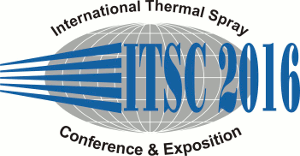
|
4646 |
|
Wednesday, May 11, 2016, Yellow River Hall 5:00 PM Aviation Industry III |
|
Cold spray of metal-polymer composite coatings onto carbon fiber-reinforced polymer (CFRP) |
|
Vincent Bortolussi* / MINES Paristech
Centre des Matériaux, FRANCE François Borit / MINES ParisTech, PSL Research University, MAT - Centre des matériaux, CNRS UMR 7633, BP 87, 91003, France Vincent Guipont/ MINES ParisTech, PSL Research University, MAT - Centre des matériaux, CNRS UMR 7633, BP 87, 91003, France Michel Jeandin/ MINES ParisTech, PSL Research University, MAT - Centre des matériaux, CNRS UMR 7633, BP 87, 91003, France Matthieu Faessel/ MINES ParisTech, PSL Research University, CMM - Centre de Morphologie Mathématique, 35, rue Saint-Honoré, 77305, France Bruno Figliuzzi/ MINES ParisTech, PSL Research University, CMM - Centre de Morphologie Mathématique, 35, rue Saint-Honoré, 77305, France François Willot/ MINES ParisTech, PSL Research University, CMM - Centre de Morphologie Mathématique, 35, rue Saint-Honoré, 77305, France Kevin Roche/ Dassault Aviation, France Anthony Chesnaud/ MINES ParisTech, PSL Research University, MAT - Centre des matériaux, CNRS UMR 7633, BP 87, 91003, France |
|
The growing use of Polymer-Matrix Composite (PMC) materials within transport industry raises new security concerns, especially those due to lightning. To protect these electrically insulating materials, conductive coatings can be applied. Due to the high level of required properties, cold spray is believed to be an effective way to achieve these coatings. Recent studies showed that obstacles remained to be overcome when cold spraying metallic particles onto Carbon Fiber-Reinforced Polymer (CFRP). These are rather due to a poor adhesion of metallic particles onto carbon fibers, which prevents coating build-up. This study therefore developed the use of PEEK addition to metallic powder. The goal is to promote the coating-substrate bond strength provided that the coating could be electrically conductive. The work focusses on composite coatings made of PEEK thermoplastic polymer powder and copper powder. The influence of spraying parameters, powder shape, size and distribution were investigated for various polymer ratios. Depending on these parameters, various microstructures could be achieved, which resulted in different electrical and bonding properties. Coating cross-sections were studied using morphological operations coupled with quantitative image analysis. Relevant parameters to feed a model for simulation of the sprayed microstructure were thus determined. This model as an effective optimization tool allowed to carefully select powders and mixture composition to produce adherent and electrically conducting coatings. Electrical properties were assessed using the Van der Pauw method with dedicated device and samples. The latter were specifically designed to lead to significant and accurate resistance measurements. These measurements showed the feasibility of PEEK-copper composite coating of CFRP. Incidentally, beyond electrical applications, this type of cold-sprayed composites can be claimed to be suitable for a large range of applications. |